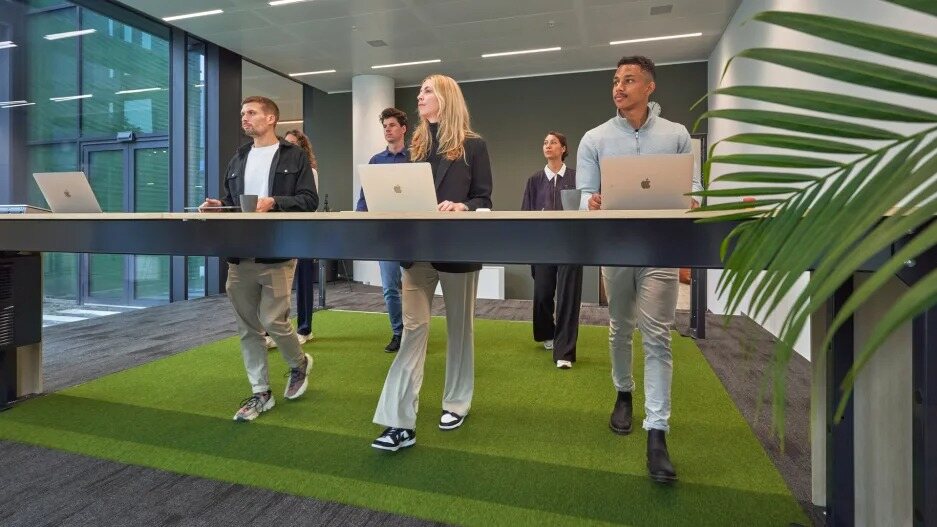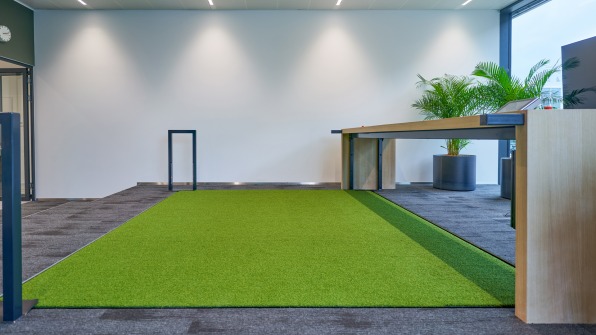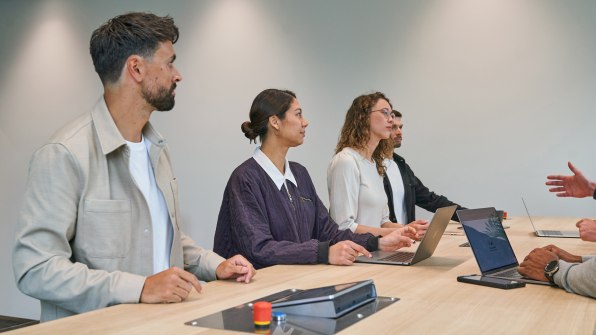- | 8:00 am
So long treadmill desks! Meet the Walking Room
An office building in Amsterdam is turning one of its rooms into a giant treadmill.

I’m standing in a glassy conference room on the ground floor of an office building in Amsterdam, staring down at a carpet made of grass. At the far end of the carpet is a rectangular desk, a long wooden table with four steel legs and a touchscreen embedded into its surface. Touch the button on the screen, and suddenly the carpet will start to glide, slipping the entire room beneath your feet as it forces you to walk along.
This contraption is the world’s first “walking room.” Think of it like a treadmill desk, but instead of a narrow belt, you get a moving carpet the size of a 10-by-12-foot room that can fit at least 8 to 10 people (there’s leftover space for people who wish to remain stationary). This walking room is located inside the EDGE Stadium, a new office building looking to lure new tenants.

But the Walking Room isn’t just a one-off amenity in a one-off building: It’s a company founded by a physiotherapist and a former professional tennis player who are on a mission to empower people to live healthier lives by bringing movement into the workplace. As such, this pilot project is the first of what they hope will be many “walking rooms” in offices around the world.
The premise is pretty simple: Instead of sitting around a conference table, you can book a time slot in a walking room and walk on a giant treadmill during your meeting. The room has three speeds, with the most commonly chosen being 1.5 or 2 mph, with the less popular option for “power walk” mode, which clocks in at just over 3 mph. Walking Room founders, Guido Boumann and Matthijs Verdam, explain that the slower speed is ideal for taking phone calls and doing focused tasks, while the medium speed is perfect for group meetings and one-on-ones.

For safety, two emergency buttons are located on either end of the table. The system also features two railings for additional support, and sensors that will automatically switch off the machine if you get too close to the back edge. At the EDGE Stadium, the walking room is raised on a plinth, about 10 inches off the ground, that can be accessed by a few steps or a switchback ramp. The treadmill is embedded within that plinth, so it is flush with the rest of the floor, and walking on and off feels seamless.
Not unlike the slew of treadmill desk companies that have proselytized the benefits of working while working over the past 15 years, the founders believe, rightfully, that sitting is the new smoking and that taking a walking meeting can increase your overall health, boost your energy, reduce your stress levels, increase your productivity, and get your creative juices flowing more easily. “We found out that [we can help] people to achieve their health objectives by creating something they can do during work hours and together,” says Boumann. “So, we came up with the idea of a treadmill to attract people to the treadmill and get them moving.”

Working with researcher at the Amsterdam University of Applied Sciences, the founders conducted a six-month-long study involving 170 male and female office workers, averaging 40 years old. Some participants tested individual treadmills, like the kind you’d see in a gym, while others were grouped together so they could work on their own treadmills, but in proximity to one another. The results were promising: 65% said they felt more productive, 62% said they felt less stressed, and 60% said they felt more creative.
But this is where it gets interesting: In that same study, the team found that people were a lot more enthusiastic when they were on treadmills and grouped together. “When we split them up again, nobody used them,” says Verdam.
It’s worth noting that studies on individual treadmill desks are a bit murkier. Ever since the first treadmill desk was introduced in the late 2000s, studies have shown mixed results: Some reported negative impacts on learning, processing speed, and attention; others found positive impacts on short-term memory and attention. A more recent study found that treadmill desks increase your overall energy, but found no evidence of statistically significant changes in other metabolic outcomes, like blood pressure.
The Walking Room, however, is about more than energy and productivity—it’s about team spirit. In the wake of COVID-19, fostering team spirit in the workplace is now on everyone’s minds as companies continue looking for creative ways to lure people back into the office.

When I visited the building in mid-March, no tenants had been confirmed yet, but Florjin Vriend, head of wellbeing and social impact at EDGE, is enthusiastic about the Walking Room’s value to the building. She heard about Walking Room from a friend and went to test a prototype in a warehouse outside of Amsterdam. “[At first] it was seen a little bit as a gimmick, but as we worked on it, the enthusiasm really grew from all sides,” she says.
For Vriend, the Walking Room is just one tool in her company’s toolbox to get workers back to the office. And it’s a pretty trendy tool, too. She mentions famous CEOs, like Mark Zuckerberg or Steve Jobs, who have been known to take walking meetings to brainstorm new ideas or woo prospective employees. “Given the weather outside, I think this is a good option, at least in the Netherlands,” she says with a laugh.





































